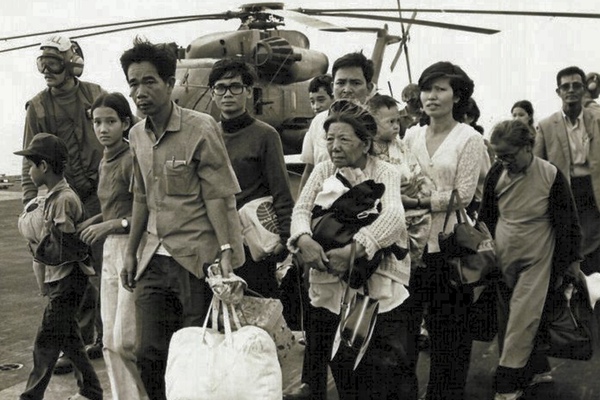The Iraqi Fall of Saigon?

Forty years ago Americans were stunned by images of North Vietnamese tanks rolling into the heart of Saigon. The Vietnam War had bitterly divided the nation and cost 58,220 American lives. Responding to American public opinion, then President Gerald R. Ford declined to intervene—a tacit admission of defeat.
Today, Americans are stunned by images of another anti-American force, this one on the move toward Baghdad, only recently vacated by American troops. The war in Iraq has bitterly divided the nation. At this writing, the American-trained Iraqi army has collapsed, and pleas for American help are falling on deaf ears.
Déjà vu all over again?
As in Vietnam in 1975, when Saigon fell, the rapidly unfolding events in Iraq are beyond America’s capability to control. The US-led invasion gave the Shi’ite majority control of the government and solidified the Shi’a triangle of Iran, Lebanon and Southern Iraq.
US commanders successfully wooed the Sunnis for a time in the much heralded ‘Sunni Awakening’ during which they succeeded in allying Sunni tribal leaders with the Shi’ite government in the fight against Al Qaeda. The fact remained that the Iraqi Army, from the platoon level up, had already segregated themselves along confessional lines, with the Sunnis effectively relegated to the status of uniformed observers.
Once in power, the Shi’ite parties no longer felt beholden to keep their pledges to Sunni tribal leaders. The Americans departed the scene leaving Iraq free to form a Shi’ite state. However, the Shi’a electoral triumph was short lived. This time, events do not involve merely a change of management. Rather, the nation-state model is threatened.
As the Iraqi government faces collapse, events in neighboring Syria have taken on transcendent importance. There, the Alawite (heterodox offshoot of Shi'ism) Assad regime in Damascus claims to rule a nation that is 87% Muslim. The majority of these Muslims are Sunni. A transnational coalition of Sunni jihadists was on the brink of putting an end to the Assad regime when the Lebanese Shi’ite Hezbollah intervened, stabilizing the battlefront.
The Sunni forces in Iraq are led by a loosely confederated organization with the memorable name ISIS (Islamic State of Iraq and the Levant). Their objective reflects the fervent dream of all Sunni jihadists: the restoration of the Islamic Golden Age, the era of Muslim empires like the seventh-century Umayyads and the eighth-century Abbasids (such a restoration that would do away with the state borders imposed by the West during its colonial period). The Sunni confederation now threatening the Syrian regime harbors this dream. It is tantalizingly in reach because ISIS has captured Mosul, a mere 68 kilometers north of Baghdad.
With the Iraqi army effectively moribund, Grand Ayatollah Ali al-Sistani, the presumedmarj-e-taqlid (the man recognized as the greatest scholar of the age), has called for Shi’ite volunteers to take up the fight. Tellingly, the call is to defend Shi’ite shrines rather than the Iraqi state. Fear for the shrines is real. In 2006, the bombing of the al-Askari mosque in Sammara, which is revered by Shi’ites, set off a Sunni vs. Shi’ite civil war that effectively ended American hopes for a united democratic Iraq.
Shi’ite fears are also quite real.
In the 1930s Sunni jihadist tribesmen brought the al-Saud regime to power, creating the modern kingdom of Saudi Arabia. When tribal Sunnis targeted the Shi’ite population in the oil rich Eastern Province, it took strong military intervention by the Saudi army to prevent massive bloodshed.
Also, in the 1990s the ruling Taliban (Sunni) in Afghanistan launched an unprovoked expedition against the Hazaras—the only Shi’ite tribe in the country—with the objective of purging Shi’ism from the nation. The public backlash against this enterprise left the Taliban without support when the Americans invaded the country after 9/11.
As for ISIS, it claims to release captured Sunni soldiers and execute Shi’ites.
With the certainty of a bloodbath in Iraq and, in tandem, a renewed push toward Damascus by Sunni jihadists in Syria, the US has many interests at stake but few options.
Radicalized citizens of Western nations are pouring into Syria to take up the fight and it is a near certainty that they will add Iraq to their itinerary. This is of grave concern because the return of battle hardened jihadists to the West promises a dangerous wave of violence. Western intelligence services are hyper-focused on tracking these fighters and arresting them on their return to their home countries.
These concerns pale in comparison to the costs of victory by Sunni Jihadists. In contrast to the overblown fears that a communist Vietnam would cause adjoining states to fall into communist hands, there is a serious risk of a convulsion that could engulf the weaker states in the Middle East. The hapless Lebanon will be first to fall.
This leaves the U.S. with the impossible choice of either supporting Shi’ite hegemony in Iraq when up to 90% of the world’s Muslims are Sunni, or standing aside and letting events take their course at the cost of the lives of former allies and vital oil interests in the region.
The Obama administration, whose failure to make a timely decision in Syria allowed foreign jihadists and Hezbollah to take command of the field, is again debating its response as Sunni and Shi’ite forces prepare for war.
Déjà vu?
Resources:
“Statistical Information about Fatal Casualties of the Vietnam War.” National Archives, August 2013, Military Records. http://www.archives.gov/research/military/vietnam-war/casualty-statistics.html#category./.
“The World Factbook.” Central Intelligence Agency, May 29, 2014, Middle East: Syria. https://www.cia.gov/library/publications/the-world-factbook/geos/sy.html.
Kaplan, Jeffrey, "Eating Hearts: A Terrorist message For Hezbollah," Sightings, May 30, 2013. https://divinity.uchicago.edu/sightings/eating-hearts-terrorist-message-hezbollah-jeffrey-kaplan.
“Mapping the Global Muslim Population.” Pew Research Religion & Public Life Project, October 7, 2009, Polling and Analysis. http://www.pewforum.org/2009/10/07/mapping-the-global-muslim-population/.
Image: Vietnam War Memorial in Washington DC; Credit: reed_sandridge / flickr via Compfight